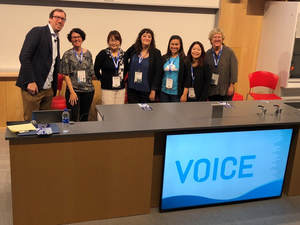
Have you been at a party and seen someone ask Alexa or Siri to play happy birthday? Have you wondered how voice and intelligent assistants will evolve? There are plenty of projections on the future of voice. For example, Comscore states that 50% of searches will be voice by 2020 or that that 55% of US households will own a smart speaker by 2022 according to OC&C Consultants. The 2018 Voice Summit was held at the New Jersey Institute of Technology in Newark New Jersey. I attended the summit to cut through the hype and find out how enterprises are using voice technology currently.
The voice ecosystem is maturing and there is around 95% speech recognition accuracy due to improvements in machine learning techniques, computer performance, and better methods for training Deep Neural Networks. Voice enabled hardware like Amazon Echo, Apple HomePod, and Google Home are readily available. The software building blocks and platforms for easy app development are there for developers to create killer applications. Voice enabled devices are expanding to include cars and wearables in addition to mobile devices and smart speakers.
A Leaders in Voice Panel with Heidi Culbertson CEO of Ask Marvee, Cathy Pearl Head of Conversation at Google, Chiori Hori Principal Research Scientist at Mitsubishi, Brooke Hawkins Content Designer at Nuance, and Justina Nguyen Developer Evangelist at Dashbot was moderated by Bradley Metrock executive producer of the Alexa conference provided a lot of insight around this space.
Key areas for voice in the enterprise are productivity and concentration monitoring of enterprise workers. Workers that can use both hands on their task and can use voice to control certain tasks have seen increased productivity. Some use cases are booking meetings via calendar app, starting a conference call, entering data into multiple systems without going to multiple windows, and checking inventory to name a few. New custom Google Actions and Alexa skills are being developed everyday as enterprises are realizing the power of voice control beyond speech to text for typing.
Nevertheless, there are many concerns that need to be addressed as voice control becomes more commonplace in organizations. Speech recognition accuracy reduces significantly for non-native English speakers, accents, and speech impediments. Accuracy also goes down in noisy environments. Another concern is the slow adoption of additional languages support. Training speech recognition algorithms on data that represents all potential speakers in non-ideal conditions in a variety of languages can help improve this.
The voice ecosystem is maturing and there is around 95% speech recognition accuracy due to improvements in machine learning techniques, computer performance, and better methods for training Deep Neural Networks. Voice enabled hardware like Amazon Echo, Apple HomePod, and Google Home are readily available. The software building blocks and platforms for easy app development are there for developers to create killer applications. Voice enabled devices are expanding to include cars and wearables in addition to mobile devices and smart speakers.
A Leaders in Voice Panel with Heidi Culbertson CEO of Ask Marvee, Cathy Pearl Head of Conversation at Google, Chiori Hori Principal Research Scientist at Mitsubishi, Brooke Hawkins Content Designer at Nuance, and Justina Nguyen Developer Evangelist at Dashbot was moderated by Bradley Metrock executive producer of the Alexa conference provided a lot of insight around this space.
Key areas for voice in the enterprise are productivity and concentration monitoring of enterprise workers. Workers that can use both hands on their task and can use voice to control certain tasks have seen increased productivity. Some use cases are booking meetings via calendar app, starting a conference call, entering data into multiple systems without going to multiple windows, and checking inventory to name a few. New custom Google Actions and Alexa skills are being developed everyday as enterprises are realizing the power of voice control beyond speech to text for typing.
Nevertheless, there are many concerns that need to be addressed as voice control becomes more commonplace in organizations. Speech recognition accuracy reduces significantly for non-native English speakers, accents, and speech impediments. Accuracy also goes down in noisy environments. Another concern is the slow adoption of additional languages support. Training speech recognition algorithms on data that represents all potential speakers in non-ideal conditions in a variety of languages can help improve this.

Some organizations haven’t utilized intelligent assistants because of security or privacy concerns around conversations being captured and stored for targeted ads, building profiles, and other unknown reasons. A talk by Joshua Montgomery CEO of Mycroft an open source voice enabled speaker, presents a great option for organizations with these concerns that don’t want to miss on the voice user interface. The Mycroft smart speaker doesn’t store any of your data, is customizable, and plans to do all voice processing on device and could be used to create an end to end encrypted on premise voice solution. Another private by design voice assistant and platform to mention is Snips.
Voice is here. This user interface won’t replace all other technologies. Rather like human conversation users will choose the best interface for each situation. Healthcare is a vertical with a lot of voice enabled innovations as patients that can’t move or have pain with movement is a use case where voice control is a must have. We are excited to see many more use cases and businesses that leverage voice as a user interface in the enterprise.
Voice is here. This user interface won’t replace all other technologies. Rather like human conversation users will choose the best interface for each situation. Healthcare is a vertical with a lot of voice enabled innovations as patients that can’t move or have pain with movement is a use case where voice control is a must have. We are excited to see many more use cases and businesses that leverage voice as a user interface in the enterprise.
 RSS Feed
RSS Feed